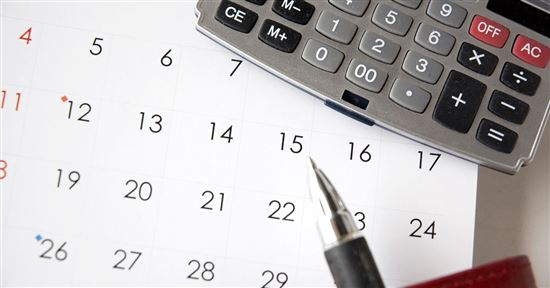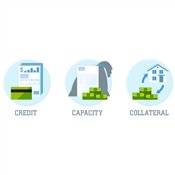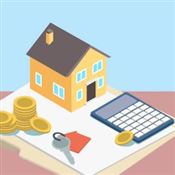What Percentage of Income Should Go to Mortgage?
Figuring out how much of your monthly income should cover your mortgage can seem overwhelming. What do the banks allow? What amount are you comfortable paying? We explore these and other questions to help you find the right mortgage payment.
The Reality of Mortgage Payments
 |
The fact is the amount you'll be paying every month to your mortgage company includes more than just the loan itself. Every month you'll be paying the loan's principal as well as the interest on the loan, your real estate taxes, and homeowner's insurance.
And if you do not put 20 percent down on the home from the start, you may also have private mortgage insurance (PMI) tacked on every month.
You need to have a rough estimate of all of these figures in order to know how much house you can afford - and to figure out if you can cover the monthly payments over time.
You take out a $150,000 mortgage with a $716 per month payment. Your real estate taxes equal $4,000 and your homeowner's insurance equals $900 per year. This means $333 per month for real estate taxes and $75 per month for homeowner's insurance. Your total mortgage payment equals $1,124, or $408 more than the principal and interest alone.
If you have PMI on top of this payment, it could add $100 or more onto your payment. The once affordable $716 mortgage payment suddenly looks much less affordable.
Keep in mind, you may not know the full implication of a mortgage payment when you start shopping for a home. On many home listings, however, you can see last year's real estate taxes. You can use this amount as an estimate of what you will pay each month for a particular home. Your insurance agent can also provide a ballpark estimate of homeowner's insurance rates in your area.
Take a look at
Calculating Your Monthly Income
 |
Lenders usually calculate your monthly income differently than you do. In most cases, they use your gross monthly income. This is your income before taxes. Borrowers who own their own business or work on commission are an exception. Lenders use their adjusted gross income based on their tax returns. This accounts for any work related expenses that affect your income.
Figuring out how a lender computes your income is as easy as looking at your W-2s for the last two years. Lenders calculate the average you made over those two years.
John's W-2s for the last two years are as follows:
2015 - $80,000
2016 - $84,000
Many lenders will compute that as $82,000 per year, or $6,833 per month.
If John was self-employed or paid on commission, though, lenders would use his tax returns for the last 2 years. Looking at the adjusted gross income, they compute an average over the last 2 years.
Lenders can account for the peaks and valleys of a borrower's income when they calculate the average income. This way, they do not qualify a borrower for more loan than they can afford throughout the year.
The Golden 28% Rule
 |
| © CreditDonkey |
Once you know your gross monthly income, you can calculate the right mortgage payment. We believe in the 28% rule. We talk about this in detail in our article "How Much House Can I Afford."
Calculating 28% of your gross monthly income provides you with the total mortgage payment you can afford.
John, in the above example, makes $82,000 annually, or $6,833 per month. 28% of his income looks like:
$6,833 x 0.28 = $1,913
This is the TOTAL mortgage payment. If real estate taxes are $4,000 and homeowner's insurance is $900 per year, this leaves $1,505. This can cover the principal, interest, and mortgage insurance (if necessary).
$1,913 - $900 - $75 = $1,505
Watch Your Back-End Ratio
 |
| © CreditDonkey |
Do not forget about your other monthly obligations, though. Monthly bills, such as credit cards, student loans, car payments and personal loans, all add up. Adding these debts to your proposed mortgage payment creates your back-end ratio. The general rule is to keep this ratio at or below 36 percent of your gross monthly income.
Minimum credit card payments + student loan payments + auto loan payments + personal loan payments = Other Monthly Obligations
Other Monthly Obligations Total + Total Proposed Mortgage Payment = Total Monthly Debt
Total Monthly Debt/Gross Monthly Income = Back-End Debt Ratio
If this number exceeds 36 percent, you may want to lower your mortgage amount for a more affordable payment.
Save for a Down Payment
 |
The down payment you put on a home increases your buying power. If you can afford a 20 percent down payment, you put yourself in a good position. You can avoid PMI and lenders do not view you as high risk. If you cannot afford a 20 percent down payment, there are other options.
You can find loans that require no down payment, such as the USDA or VA loans. These loans, however, require specific circumstances. Only veterans of the military or their spouses are eligible for VA loans. Borrowers who purchase a home in a rural area and have low income may qualify for a USDA loan. The other loan programs available require the following down payments:
- Fannie Mae has a 3 percent down payment program
- FHA only requires 3.5 percent down
In exchange for a lower down payment, however, you usually pay some type of mortgage insurance. Fannie Mae loans require PMI. You can estimate the amount you would owe as 1 percent of the loan amount per year.
A $200,000 loan would require $2,000 per year in PMI premiums. This amounts to an additional $167 per month. You can cancel this insurance once you owe less than 80% of the value of the home. However, this could take many years.
FHA loans require mortgage insurance for the life of the loan regardless of how much you put down. Today, the FHA charges 0.85 percent of the loan amount in mortgage insurance. On the same $200,000 loan, you pay $142 per month.
With the 28% rule, you calculate your mortgage payment. For every $700 in mortgage payments, you can estimate a $100,000 loan. If you can afford $1,400 in mortgage payments, you can estimate a $200,000 loan. Add to this the amount of your down payment and you have a targeted purchase price for a home.
The more money you can afford for a down payment, the more home you can purchase. Figuring out how to save for this large expense may feel overwhelming. Visit our article "How to Save for a Down Payment on a House" for simple tips.
Figure in the Closing Costs and Prepaid Expenses
Purchasing a home requires more than a down payment and a loan. There are closing costs and prepaid expenses too. Borrowers may pay up to 5 percent of the loan amount in closing costs. On a $150,000 loan, this equals $7,500. This may take away from the money you saved for a down payment.
Lenders offer different programs and charge different fees, though. Apply with several lenders when you shop for a mortgage to find the best deal. Some lenders charge points up front or have higher interest rates, while others have a higher threshold for risk and can charge less. Comparing the loan estimate from each lender can help you find the right deal.
However, closing fees and down payments are not the only cash you may need. You may also owe prepaid expenses. This is usually the mortgage interest on your loan charged during the month after your closing. Most mortgages do not require the first payment until the following month.
The interest you pay is per diem (per day). You would owe 17 days of interest. Here is an example for a $150,000 loan at 4% interest:
$150,000 x 0.04 = $6000
$6,000/365 days = $16.48 per day
$16.48 x 17 days = $280.16
For more information on how much it really costs to purchase a home, visit our article "How Much Money Do You Need to Buy a House?"
Do You Have Reserves?
Not all loan programs require borrowers to have liquid reserves. But this is something you'll want to consider if something unexpected happens. In case of an emergency, how would you pay your mortgage? If you have cash reserves, you may be able to cover the mortgage even if your income has stopped.
If you do not have reserves, carefully consider how much you borrow. Do not take on a mortgage payment you do not have a way to cover. Just 3 missed mortgage payments can land your loan in pre-foreclosure proceedings.
The Bottom Line
 |
| © CreditDonkey |
We recommend you look at your mortgage payment in two ways:
- Keep your mortgage payment at 28% of your gross monthly income or lower
- Keep your total monthly debts, including your mortgage payment, at 36% of your gross monthly income or lower
If your monthly debts are pretty small, you can use the 28% rule as a guide. However, if you have significant monthly debts, you may need to work the process backwards.
Joe makes $50,000 per year, or $4,167 per month. His monthly debts before the mortgage equal $625. Working the process backwards looks like this:
$4,167 x .36 = $1500
$1500 - $625 = $875 left for a mortgage payment
If you used the 28% rule, Joe would have a $1,167 mortgage payment. Adding his monthly debt to this number equals $1,167 + 875 = $2,042, which exceeds the 36% benchmark.
Once you know a comfortable payment for you, try to work it into your budget. Set aside the proposed mortgage payment amount for a few months to see how it feels (you could use the funds toward your down payment). Are you comfortably paying your other bills? Do you have money for daily living expenses? This gives you a good idea of what you can expect with a new mortgage. If you find it hard to afford the payment, consider a smaller loan amount.
Remember, a mortgage is a long-term, large investment. Taking the time to make sure you can afford it will make your financial life less stressful in the end.
Write to Kim P at feedback@creditdonkey.com. Follow us on Twitter and Facebook for our latest posts.
Note: This website is made possible through financial relationships with some of the products and services mentioned on this site. We may receive compensation if you shop through links in our content. You do not have to use our links, but you help support CreditDonkey if you do.
Read Next:






